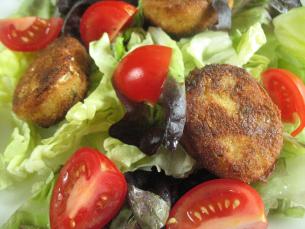On a recent visit to New York City, the weather was cold and crisp. On such days, my husband (David) and I always share a small brown bag full of freshly roasted chestnuts from one of the street vendors who seem to be on every other NYC street corner. After letting the chestnuts cool down for a few minutes, David always peels these delightful treasures so I don’t have to take my mittens off! They are so rich, sweet and tender!
When I saw fresh chestnuts at the grocery store, I thought it would be great to roast some at home for startcooking. For comparison sake, I bought a jar of pre-packaged chestnuts as well.
Before I begin, I would like to point out that Water Chestnuts are from an aquatic plant and are a totally different food than the chestnuts (from a tree) that I am about to roast.
To Roast Chestnuts:
Preheat your oven to 425 degrees F.
Wipe the chestnuts off with a damp towel and set them on a cutting board, flat side down.
With a small, sharp knife cut an X in each chestnut. (There are special chestnut-X-cutting knives that you can buy – see comments below. I would only recommend buying one of these knives if you roast a TON of chestnuts.) The X allows the steam to escape while they are cooking. (Do not omit this step, otherwise the chestnuts could explode in the oven!) This will also make peeling a lot easier.
For safety sake, you may feel more comfortable cushioning the chestnut on a (clean) dish towel to cut the X.
Put the chestnuts in a baking pan with the X facing up.
It will take 20-30 minutes to roast the chestnuts. When cooked, the shells will burst open, and the chestnut will be golden brown. The tricky part is actually knowing when they are done. If you over-cook OR under-cook them, they will get hard and the inner skin will be very difficult to remove.
Now comes the hard part: peeling them! You need to peel them while they are still warm. Let them cool just enough so that you can touch them, then start peeling. Be very careful not to burn your fingers!
Be sure to buy extra, because once they are open you may well discover that some have actually turned bad and are not edible.
This task is not as easy as David makes it look. My thumb is killing me!
So now comes the test: comparing the fresh chestnuts to the ones from the jar. There are four things to consider:
- Appearance
- Taste and Texture
- Price
- Convenience
Freshly Roasted (on the left) Vs. From a Jar
1. Appearance
First let me say that the chestnuts I bought from Whole Foods did not end up looking at all like the magnificent ones from the street vendor. (Of course the 7 or 8 chestnuts from the street vendor that actually end up in your brown bag don’t look like the ones they have on display either!)
The ones from the jar have a preserved look about them.
2. Taste and Texture
They both tasted delicious but the ones from the jar actually had a moister texture.
3. Price
The 17 fresh chestnuts from Whole foods cost $4.67
I ended up with 12 usable ones. (Yes there are only 11 in the above photo because I ate one!) Two I could not get peeled, two disintegrated when I tried to peel them and one was rotten.
The 7.4 ounce jar cost $8.99. 100% were usable.
4. Convenience
When I was a kid, whenever my mom would bake, we would always have to shell the walnuts. (Way back then!) It was significantly cheaper to buy unshelled walnuts. It is a very labor intensive activity. Today, having to shell your own nuts sounds like it is on par with having to go milk the cow to get fresh milk! Peeling your own chestnuts is not an easy task!
Conclusion:
All in all, my first preference is to buy them off the street vendor in NYC. ONLY as a special treat, is it worth the effort to roast the chestnuts yourself. The look, the taste and the aroma is wonderful.
BUT, for use in a recipe, I would probably skip roasting them myself and just buy the jar!
Cheers!
If you are new to startcooking, or are a regular visitor here, please consider subscribing for free.


















